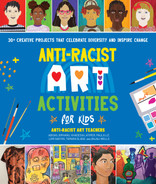- Activism:
- Using your actions to bring about change.
- Activists:
- People who advocate for a cause by using their voice and actions to create change.
- Advocacy:
- Supporting a cause or mission by standing up for it with your words, actions, and art.
- Aesthetics:
- How we personally interpret and appreciate beauty.
- Ally:
- Helper or supporter who stands up for a group they do not belong to, often using their privilege to do so.
- Anti-racism:
- A lifelong commitment to taking action against racism. We do this by revealing, stopping, and preventing racism among people, systems, and institutions.
- Anti-racist:
- A person who opposes racism and promotes racial understanding and valuing of all peoples.
- Artivism:
- Using your art and actions to bring about change.
- Bias:
- Favoring or showing prejudice toward certain people or ideas.
- Brave space:
- Communities where people respect and hold each other accountable. They do not tolerate bias, racism, or any other form of hate or harm. They embrace differences and allow the opportunity to understand diverse perspectives and cultivate connections.
- Colonization:
- When a country or empire takes over an area that is not theirs to gain wealth and power, doing whatever it takes to get control. Often this includes wars and violence against the Native and Indigenous peoples who live there.
- Community:
- A group of people with something in common, which often includes an identity label, such as being from a particular area or belonging to an identity group.
- Compassion:
- Caring for the needs of others and taking action to help them.
- Consent:
- Agreeing or giving permission for something.
- Culture:
- A way of life that can include, but is not limited to, aspects of values, food, drink, language, clothing, hairstyles, art, music, tools, humor, knowledge, traditions, stories, memories, technology, manners, celebrations, abilities, and more.
- Cultural appropriation:
- Taking a cultural practice that does not belong to your culture and using it for profit or personal gain without permission or the knowledge and deep cultural understanding of the history behind the cultural practice.
- Discrimination:
- The unjust treatment of a group of people, usually because of their race, ethnicity, gender identity, age, ability, body size, and more.
- Diversity:
- Showcasing a variety of different things; a state of being diverse.
- Empathy:
- Understanding and feeling what someone else is feeling or could feel.
- Empathy gap:
- Having less empathy for someone because you do not share their identity or similar experiences.
- Equity:
- Fairness, or making sure people have what they need rather than giving everyone the same amount or treatment.
- Ethnicity:
- A cultural identity. A group of people who identify with one another with similarities such as history, culture, language, ancestry, etc.
- Gender identity:
- How you experience your gender. You can experience your gender through your identity (pronouns), body (appearance), and expression (how you act and dress). Some gender identities include nonbinary, girl, and boy.
- Identity:
- The different parts about yourself that make you who you are.
- Implicit bias:
- Unconsciously judging others and making assumptions about them based on their identity.
- Inclusion:
- The state of including all within a group or structure.
- Intersectionality:
- Civil rights activist Kimberlé Crenshaw introduced the theory of intersectionality as the way multiple forms of discrimination intersect.
- Justice:
- Fairness that is seen through a cultural lens. Often communities decide what justice is to them. Because justice is cultural, there are many different types of justice.
- Melanin:
- A pigment that protects our skin from the sun. The more melanin you have, the darker your skin is. The less melanin you have, the lighter your skin is.
- Mindful:
- When you are aware of yourself, how you feel, and what has made you feel that way.
- Power:
- The ability to make things happen the way one wants.
- Prejudice:
- Pre-judging a person or group of people with little or no knowledge.
- Privilege:
- A special right or advantage available to only a particular person or group of people.
- Pronouns:
- People can use gender pronouns in place of names. Examples of pronouns include they/them, she/her, he/him, and more.
- Race:
- An attempt to label people based on their appearance through their ancestry and cultural customs. Race is socially constructed and has changed over time.
- Racial stereotype:
- When you group and label people in your mind based on their race. These labels are often inaccurate and oversimplified.
- Racism:
- Unfair laws, rules, and systems created by people with power and prejudice against specific racial groups.
- Reciprocity:
- When people exchange something to help and support each other.
- Social commentary:
- Promoting change by informing the public about a current issue.
- Social justice:
- The belief and drive that all people should have access to what they need to survive and thrive.
- Stereotype:
- When you group and label people in your mind. These labels are often inaccurate and oversimplified.
- Textile:
- Another word for fabric, which includes all kinds of fabrics from clothes to rugs and even artwork made of cloth.
- Wet-on-wet:
- A watercolor painting technique in which you wet your paper or canvas first with water and then add paint.
- White supremacy:
- The false idea that whiteness is superior, which can influence our minds, laws, rules, and systems.
..................Content has been hidden....................
You can't read the all page of ebook, please click here login for view all page.
